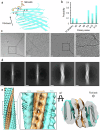Allosteric amyloid catalysis by coiled coil fibrils
- PMID: 40450012
- PMCID: PMC12126523
- DOI: 10.1038/s41467-025-60379-z
Allosteric amyloid catalysis by coiled coil fibrils
Abstract
Amyloid-mediated catalysis of key biological reactions has recently attracted significant interest as this phenomenon may portend new functions for physiological and synthetic amyloid proteins. Here, we report an allosteric mechanism of catalytic amyloids, mediated via an unconventional coiled-coil fibril organization, facilitating hydrolysis of β-lactam antibiotics. Specifically, the hydrolysis reaction was catalyzed by a fibrillar peptide comprising alternating lysine/phenylalanine β-sheet-forming sequence. Analysis of peptide variants, simulations, and cryogenic electron microscopy reveal that the β-lactam molecules attach electrostatically to the lysine sidechains on the fibrils' surfaces, generating a double-coiled fibril structure in which the anchored β-lactam molecules are nestled within twisted fibril strands. This organization facilitates the allosteric catalytic process in which hydrolytic β-lactam ring opening is induced via nucleophilic attacks by the lysine sidechains degradation. The allosteric catalytic activity of the phenylalanine/lysine amyloid fibrils highlights the functional versatility of amyloid fibrils and their potential applications in human health and environmental biotechnology.
© 2025. The Author(s).
Conflict of interest statement
Competing interests: The authors declare no competing interests.
Figures






References
-
- Arad, E., Yosefi, G., Bitton, R., Rapaport, H. & Jelinek, R. Native glucagon amyloids catalyze key metabolic reactions. ACS Nano16, 12889–12899 (2022). - PubMed
-
- Arad, E., Baruch Leshem, A., Rapaport, H. & Jelinek, R. β-Amyloid fibrils catalyze neurotransmitter degradation. Chem. Catal.1, 908–922 (2021).
MeSH terms
Substances
LinkOut - more resources
Full Text Sources

